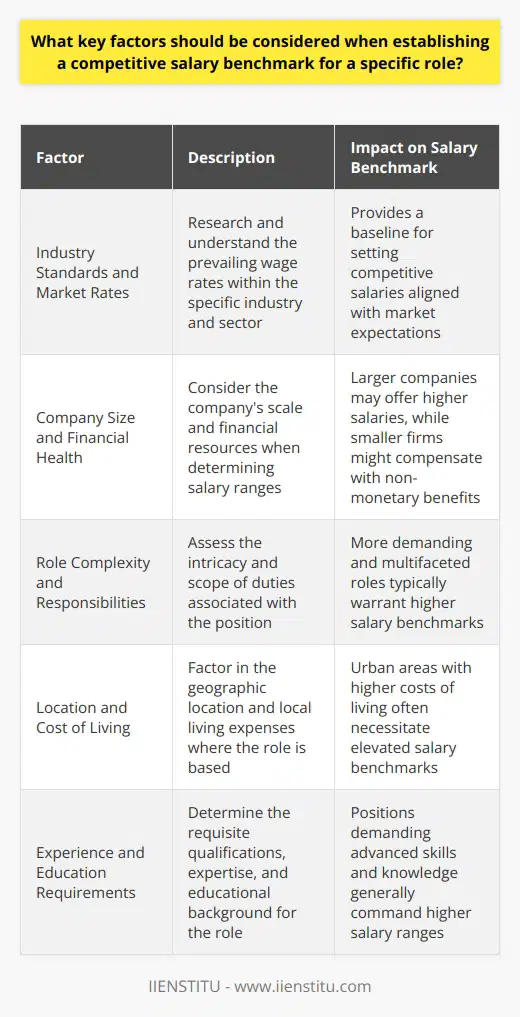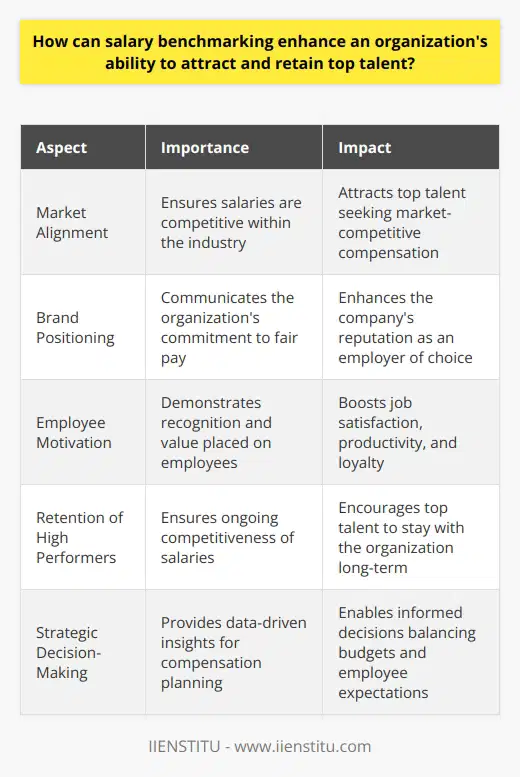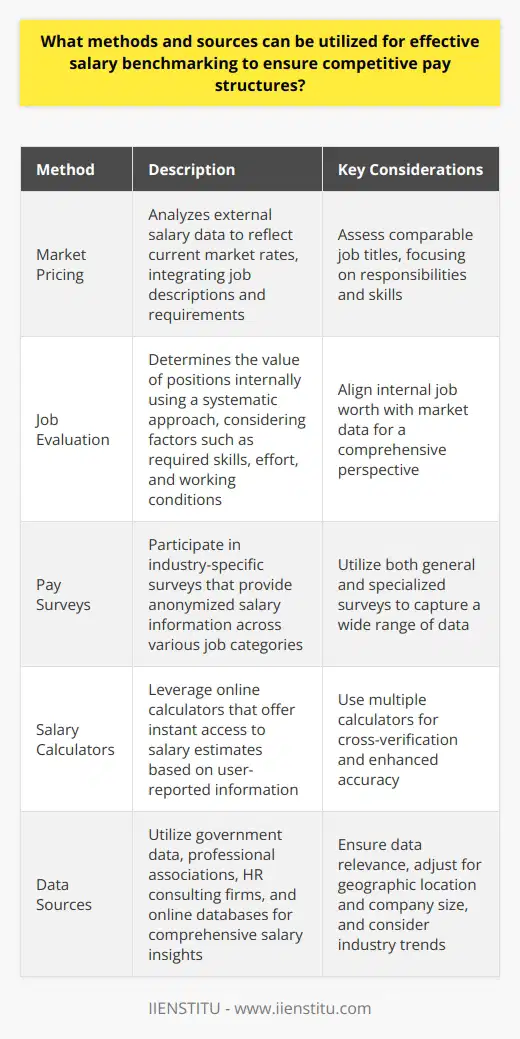
The discipline of salary benchmarking is an essential facet of a strategic approach to human capital management within modern organizations. This salient practice involves the systematic comparison of job salaries both within a company and against external markets or peers. It serves as the foundation upon which equitable, competitive, and sustainable pay structures can be built. As the business arena grows ever more competitive, companies vigorously vie for top industry talent, further amplifying the importance of effective remuneration strategies to attract and retain high-caliber professionals.
Here, we will delve into the intricate elements of salary benchmarking, illuminating its importance in shaping a robust compensation framework that aligns with both market standards and organizational goals.
Understanding Salary Benchmarking
Definition and explanation of salary benchmarking
Salary benchmarking is a strategic tool employed by organizations to gauge the competitiveness of their compensation packages. In essence, it involves analyzing job descriptions, delineating roles and responsibilities, and drawing performance metrics against a comprehensive set of market data that includes salaries, bonuses, and other remuneration elements.
This informed approach ensures that pay scales are not only aligned with organizational objectives but also echo the prevailing trends in the labor market.
Overview of the process of salary benchmarking
The salary benchmarking process can be methodized into several key stages. Initially, it necessitates identifying job roles that are pivotal to the organizational structure and warrant comparison. Subsequently, selecting a congruent set of comparison companies ensues, typically those within the same industry, of similar size, or which compete for the same talent pool. The third phase involves collecting data which may emanate from job adverts, industry reports, or specialized salary surveys.
Lastly, analyzing the data involves weighing the internal job worth against external market rates, enabling informed decision-making regarding compensation adjustments.
Example of salary benchmarking within an organization
To exemplify the application of salary benchmarking within a real-world context, consider a technology firm looking to establish pay rates for a new software development role. The firm would start by defining the specific competencies, responsibilities, and required experience for the position before identifying a selection of peer companies and mining for data on what they pay individuals in similar roles.
Once the data is collected and analyzed, the firm could confidently set a competitive salary that not only entices skilled developers but also maintains internal parity.
Benefits of Salary Benchmarking
Ensuring competitive remuneration within the industry
The cornerstone of salary benchmarking lies in its capacity to equip organizations with the insight needed to offer salaries that are competitive and congruent with industry benchmarks. This is particularly critical in sectors where demand for talent outweighs supply, as in the fields of technology and specialised healthcare.
Attracting and retaining top talent
A direct correlation exists between competitive compensation structures and an organization's ability to attract and retain the most qualified employees. Salary benchmarking empowers businesses to develop pay scales that resonate with prospective candidates' expectations, while also engendering loyalty among existing staff.
Creating salary transparency within the organization
Salary benchmarking initiates an environment of salary transparency within organizations, bolstering employee trust and engagement. When employees understand that their remuneration is subject to objective criteria and reflects industry standards, it can mitigate potential discontent and foster a healthier workplace culture.
Challenges in Salary Benchmarking
Identifying comparable companies or jobs
A daunting hurdle in the salary benchmarking process is the identification of companies and positions that are legitimately comparable. Variables such as industry niche, organizational size, and geographical location must all be meticulously considered to ensure relevant comparisons.
Gaining access to accurate salary data
Obtaining reliable and up-to-date salary information can be onerous. Organizations must not only secure access to high-quality data but also discern its pertinence to the specific roles and markets relevant to their benchmarking endeavours.
Keeping up-to-date with salary trends and market changes
The dynamic nature of salary structures and the labor market further complicates the benchmarking process. Being vigilant and responsive to market shifts and emerging salary trends is imperative for companies that seek to maintain competitive and fair compensation strategies.
Best Practices in Salary Benchmarking
Regularly updating salary data
A best practice in salary benchmarking is the maintenance of a continual review cycle. This ensures that an organization's salary data remain fresh and reflective of current market conditions, thereby supporting ongoing competitiveness.
Diversifying sources of salary data
To uphold the robustness of benchmarking practices, organizations should pull from a variegated pool of data sources. This includes leveraging online courses with certificates, surveys from industry bodies, and leveraging human resources course knowledge, among others.
Involving multiple stakeholders in the process
It is beneficial to solicit insights from multiple departments within the organization during the salary benchmarking process. This collaborative approach can yield a more comprehensive understanding of role complexities and expectations, leading to more accurate benchmarking.
The Role of Technology in Salary Benchmarking
The use of modern tools in compiling and analyzing salary data
Advancements in digital tools and software have revolutionized the process of salary benchmarking. Sophisticated algorithms and expansive databases enable more streamlined and precise data collection and analysis, significantly reducing the scope for human error and bias.
Advantages of digitized salary benchmarking
The digitization of salary benchmarking processes leads to many benefits. These include improved accuracy in data analysis, quicker turnaround times, and enhanced ability to perform complex multi-variable comparisons. All these factors greatly enhance decision-making effectiveness.
Case studies: Effective use of technology in salary benchmarking
By reviewing case studies where technology played a critical role in the salary benchmarking process, organizations can learn best practices and potential pitfalls. For example, a company may apply machine learning models to forecast pay trends, incorporating these insights into their remuneration strategies.
In this era of fast-paced business environments, the practice of salary benchmarking emerges as a non-negotiable in the formulation of compet_backenditive and equitable pay structures. From attracting and retaining top talent to ensuring regulatory compliance and fostering transparent organizational cultures, salary benchmarking dynamically fortifies an organization's positioning within the intricate tapestry of the modern workforce. Reflecting on the crucial aspects discussed – the definition and benefits, the challenges and best practices, and the transformative impact of technology – it becomes increasingly clear that the conscientious application of salary benchmarking is not merely beneficial but imperative for the sustainable growth and success of any forward-thinking company.
Frequently Asked Questions
What key factors should be considered when establishing a competitive salary benchmark for a specific role?
Understanding Competitive Salary Benchmarks
Establishing a competitive salary benchmark is crucial. It ensures fair compensation. It also attracts top talent. Many factors influence these benchmarks.
Industry Standards and Market Rates
Research industry standards. Know the market rates. They vary by sector. They dictate the baseline salaries. Companies must be aware. They must adjust accordingly.
Company Size and Financial Health
Consider company size. Factor in financial health. Larger enterprises often pay more. They have more resources. Smaller businesses may offer less. They might provide non-monetary benefits instead.
Role Complexity and Responsibilities
Evaluate the role's complexity. Understand the responsibilities involved. More demanding roles command higher salaries. Less complex positions may require a lower benchmark.
Location and Cost of Living
Acknowledge the role’s location. Consider the area's cost of living. Urban centers often have higher salaries. The cost of living is usually more.
Experience and Education Requirements
Factor in required experience. Consider needed education. Higher qualifications often merit increased pay. They reflect the candidate's potential value.
Competitor Analysis
Perform competitor analysis. Know what rivals offer. Offer competitive pay to attract talent. Do not undersell or oversell your offering.
Employee Value Proposition
Understand your employee value proposition. It goes beyond salary. Incorporate career development and company culture. They can increase the role's attractiveness.
Legal Considerations
Be aware of legal considerations. Many jurisdictions have pay equity laws. Ensure your benchmarks meet legal requirements. Non-compliance can lead to penalties.
Economic Conditions
Monitor economic conditions. They influence salary benchmarks. Recessions might suppress wage growth. Booms could increase compensation expectations.
Inflation Rates
Consider inflation rates. Salaries must account for them. They diminish purchasing power. Regular adjustments to benchmarks are necessary.
Employee Performance and Potential
Assess performance and potential. Reward exceptional talent appropriately. It encourages employee retention. It motivates others.
Supply and Demand
Understand supply and demand. Scarcity of skills drives up salaries. An abundance of candidates may lower them. Align your offer accordingly.
By considering these factors, companies can establish effective salary benchmarks. They attract and retain the right talent. This ensures competitive positioning in the market.

How can salary benchmarking enhance an organization's ability to attract and retain top talent?
Understand Salary Benchmarking
Salary benchmarking is a strategic tool. It involves assessing salaries. Comparisons occur with market standards. This analysis ensures competitive compensation.
Attraction of Top Talent
Organizations seek top talent. Salary benchmarking plays a critical role. It identifies industry pay standards. Companies can position themselves attractively. Suitable compensation packages attract potential employees. They signal commitment to fair, competitive pay.
Key Considerations
Market Alignment*: Ensures pay aligns with industry norms.
Expert Insight*: Attracts professionals seeking market-competitive salaries.
Brand Positioning*: Communicates the value the organization places on talent.
Retention of High Performers
Beyond attraction, retention is vital. High performers seek competitive renumeration. Benchmarking informs ongoing salary competitiveness. It aids in adjusting pay to changes in market conditions.
Employee Motivation
Recognition*: Employees feel valued.
Incentivization*: Enhanced job satisfaction and motivation occur.
Stability*: Staff sees long-term potential.
Strategic Use of Benchmarking Data
Data guides salary strategies. It helps tailor compensation effectively. Organizations can make informed decisions. They can balance budgets with employee expectations.
Implementing Data Insights
- Define pay grades.
- Adjust salaries periodically.
- Maintain compensation equity.
Conclusion
Salary benchmarking is indispensable. It ensures attraction and retention of talent. It fosters a culture of fairness. Ultimately, it drives organizational success.

What methods and sources can be utilized for effective salary benchmarking to ensure competitive pay structures?
Understanding Salary Benchmarking
Salary benchmarking involves comparing salaries. It ensures competitive pay structures. It attracts talent. It also retains employees. Organizations rely on various methods. Effective benchmarking uses multiple data sources.
Methods
Market Pricing
Market pricing analyses external salary data. It reflects market rates. It integrates job descriptions and requirements. Companies assess comparable job titles. They focus on responsibilities and skills.
Job Evaluation
Job evaluation determines the value of positions internally. It uses a systematic approach. It considers factors including required skills, effort, and working conditions. It aligns internal job worth with market data.
Pay Surveys
Organizations participate in pay surveys. These provide industry-specific salary information. Surveys can be general or specialized. They cover various job categories. Data is typically anonymized.
Salary Calculators
Online salary calculators offer instant data access. They provide salary estimates. These rely on user-reported information. Users should use multiple calculators. This cross-verification ensures accuracy.
Sources
Government Data
Government agencies collect labor statistics. The U.S. Bureau of Labor Statistics is a prime example. It provides wage data. It covers various occupations and regions.
Professional Associations
Many professional groups release salary surveys. They target specific industries. Members often get detailed reports. They gain insights into current pay trends.
HR Consulting Firms
Consulting firms specialize in compensation data. They offer tailored services. They include salary reports. Their data is often comprehensive and up-to-date.
Online Databases
Several online platforms provide salary information. Examples include Glassdoor and PayScale. They aggregate salary data. Users can search by job title and location.
Considerations
- Ensure data relevance
- Adjust for geographic location
- Compare similar roles
- Adjust for company size
- Consider industry trends
- Include total compensation
- Update benchmarks regularly
Robust salary benchmarking involves systematic and diverse approaches. It combines different methods and sources. It helps maintain competitive pay structures. It assists in informed decision-making. It supports strategic HR management.



